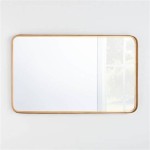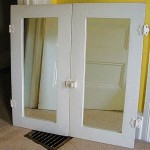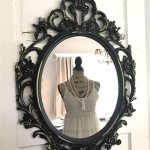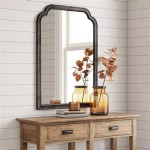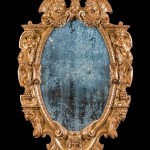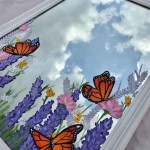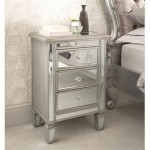How to Fix a Broken Mirror Frame
A broken mirror frame can detract from the aesthetic appeal of a room and, depending on the severity of the damage, even pose a safety hazard. Repairing a damaged frame is often a cost-effective alternative to replacing the entire mirror. The repair process varies depending on the material of the frame and the type of damage sustained. This article provides a comprehensive guide to addressing common types of mirror frame damage and implementing effective repair strategies.
Before commencing any repair work, it is crucial to assess the extent of the damage. This assessment will determine the appropriate tools, materials, and repair techniques required. Minor damage, such as small cracks or loose joints, may be addressed with simple adhesive solutions and clamping. More significant damage, such as shattered sections or warped framing, typically requires more involved reconstruction techniques.
The materials needed for a mirror frame repair will change depending on the extent of the damage. General supplies include: Wood glue (appropriate for the frame material), clamps (various sizes), sandpaper (various grits), wood filler (if applicable), safety glasses, gloves, a putty knife or scraper, cleaning solutions (appropriate for the frame material), and replacement hardware (screws, nails, etc.). For frames with decorative elements, additional supplies like paint, varnish, or gold leaf repair kits may be necessary.
Addressing Minor Cracks and Splintering
Minor cracks and splintering are common issues, particularly in wooden frames. The primary objective is to stabilize the damaged area and prevent further propagation of the crack. This often involves using an appropriate adhesive to bond the separated sections back together.
The first step is to clean the area around the crack thoroughly. Remove any loose debris, dust, or existing adhesive residue. A soft brush or a damp cloth can be used for this purpose. Avoid using abrasive cleaners that could further damage the frame's finish.
Next, apply a thin, even layer of wood glue into the crack. Ensure the glue penetrates the full depth of the crack for a strong bond. Use a small applicator, such as a toothpick or a fine brush, to reach into narrow crevices.
Once the glue is applied, carefully clamp the frame together, aligning the broken edges as precisely as possible. Utilize padded clamps to prevent indentation or further damage to the frame’s surface. The clamping pressure should be firm but not excessive. Over-tightening the clamps can exacerbate the crack or damage the surrounding wood.
Allow the glue to dry completely according to the manufacturer's instructions. Drying times can vary depending on the type of adhesive used. Generally, a minimum of 24 hours is recommended for optimal bonding. After the glue has dried, remove the clamps carefully.
Any excess glue that has squeezed out during clamping can be carefully removed with a chisel or a sharp blade. Take caution not to scratch or damage the surrounding finish. Sand the repaired area with fine-grit sandpaper to smooth out any imperfections and create a seamless transition. Progressively finer grits can be used to achieve a smooth surface.
If necessary, touch up the repaired area with paint or varnish to match the original finish. Choose a color that closely matches the existing frame. Apply thin, even coats, and allow each coat to dry completely before applying the next. Multiple thin coats are generally preferable to a single thick coat, as they are less likely to run or drip.
Repairing Loose Joints
Loose joints can cause instability in the mirror frame and eventually lead to further damage. The primary cause is often the deterioration of the adhesive that initially held the joints together. The repair process involves reinforcing the joints with fresh adhesive and potentially adding mechanical fasteners for increased stability.
Begin by disassembling the loose joint. Carefully separate the affected frame pieces, taking care not to cause any further damage. If the joint is particularly stubborn, use a rubber mallet to gently tap the pieces apart. Avoid using excessive force, which could splinter the wood or break the joint entirely.
Clean the surfaces of the joint thoroughly. Remove any old glue residue, dirt, or debris. A scraper or a wire brush can be used to remove stubborn residue. Ensure the surfaces are clean and dry before applying fresh adhesive.
Apply a generous amount of wood glue to the mating surfaces of the joint. Ensure the glue covers the entire surface area for maximum adhesion. In some cases, it may be necessary to reinforce the joint with dowels or screws for additional stability.
Clamp the joint together, ensuring the frame pieces are properly aligned. Use padded clamps to protect the frame's surface. The clamping pressure should be firm and even to ensure a strong bond. Check the alignment of the entire frame to ensure it is square and true.
Allow the glue to dry completely according to the manufacturer's instructions. As with crack repairs, a minimum of 24 hours is typically recommended for optimal bonding. After the glue has dried, remove the clamps carefully.
For added reinforcement, consider using screws or dowels to secure the joint further. Pre-drill pilot holes to prevent the wood from splitting. Countersink the screws so that they are flush with the surface of the frame. Fill the screw holes with wood filler and sand smooth. Touch up the repaired area with paint or varnish to match the original finish.
Dealing with Extensive Damage and Missing Sections
More extensive damage, such as shattered sections or missing pieces, requires more involved repair techniques. In these cases, it may be necessary to fabricate replacement sections or use wood filler to reconstruct the damaged areas.
If a section of the frame is missing, the first step is to create a replacement piece. This may involve using a similar type of wood and carefully shaping it to match the original profile of the frame. A router or a jigsaw can be used to create the desired shape.
Once the replacement piece is fabricated, it should be carefully fitted into the damaged area. Adjust the piece until it fits snugly and seamlessly. Use wood glue to adhere the replacement piece to the existing frame. Clamp the repair until it dries.
For areas with smaller missing sections or significant surface damage, wood filler can be used to reconstruct the damaged areas. Choose a wood filler that is appropriate for the type of wood used in the frame. Apply the filler in thin layers, allowing each layer to dry completely before applying the next. Overfilling the damaged area is preferable to underfilling, as the excess filler can be sanded away.
After the wood filler has dried completely, sand the repaired area smooth. Use progressively finer grits of sandpaper to achieve a smooth, seamless finish. Pay close attention to the contours of the frame to ensure the repaired area blends seamlessly with the surrounding surfaces.
Once the sanding is complete, touch up the repaired area with paint or varnish to match the original finish. Ensure the color and texture of the paint or varnish match the existing frame. Apply thin, even coats, and allow each coat to dry completely before applying the next.
If the frame has intricate carvings or decorative elements, replicating these details may require specialized skills and tools. In some cases, it may be necessary to consult with a professional woodworker or restorer to achieve a satisfactory result. Techniques such as molding using epoxy clay or recreating the design elements using carving tools are often applied.
In conclusion, repairing a broken mirror frame is a feasible task that can restore the aesthetic appeal and functionality of the mirror. By carefully assessing the damage, selecting the appropriate materials and techniques, and taking the necessary precautions, many types of frame damage can be effectively addressed. Whether dealing with minor cracks, loose joints, or more extensive damage, a methodical approach and attention to detail are crucial for achieving a lasting and visually appealing result.

How To Repair A Broken Mirror Frame Corner Designed Decor

How To Repair A Broken Mirror Frame Diy Inspired

Aleene S Original Glues How To Repair A Broken Mirror Frame

How To Repair A Broken Mirror Frame Diy Inspired

How To Repair A Broken Mirror Frame Diy Inspired

How To Repair A Broken Mirror Frame Diy Inspired

How To Repair A Broken Mirror Frame Diy Inspired

How To Repair A Broken Mirror Frame Corner Designed Decor

Whoops How To Repair A Broken Frame Tinged Blue

Aleene S Original Glues How To Repair A Broken Mirror Frame
